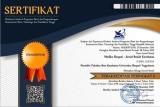INDEKS GLIKEMIK, BEBAN GLIKEMIK DAN AKTIVITAS ANTIOKSIDAN JUS KAWISTA (LIMONIAACIDISSIMA) SEBAGAI MINUMAN FUNGSIONAL PENGONTROL KADAR GULA DARAH
Abstract
Glycemic Index, Glycemic Load and Antioxidant Activity Kawista Juice (Limoniaacidissima) as a functional drink to control blood sugar levels
Background: Diabetes Mellitus is the third cause of death after stroke and heart disease in 2014. The prevalence of Diabetes Mellitus according to Basic Health Research in 2013 is almost double compared to that in 200. Diabetes sufferers in Indonesia will continue to increase from 8.4 million in the year 2000 to 21.3 million in 2030. This situation requires serious handling and attention from all parties, especially those related to nutrition and food. One of the measures related to nutrition and food is the provision of foods that have a low glycemic index, high fiber, and oxidant activity. Kawista fruit (Limonia acidissima) is one type of fruit that is currently becoming rare in Indonesia. Kawista fruit is believed to have many benefits with glucose content as a source of energy and antioxidants. Kawista fruit is believed to be used to cure tumors, asthma, treat wounds, cardiovascular disease, cardiovascular circulation and hepatitis. Flavonoids, glycosides, saponins and tannins are also contained in this fruit.
Objective: To determine the glycemic index, glycemic load, and antioxidant activity of Kawista fruit juice.
Methods: This study is quasi-experimental. Measurement of the glycemic index, the glycemic load was carried out on respondents aged 20-30 years with normal nutritional status. Respondents were checked for fasting blood sugar levels to determine the sugar levels in their blood. The intervention was carried out for 2 consecutive days. On the 1st day, the respondents were given a glucose load of 25gr and measured their blood sugar levels at 0, 30, 60, 90, and 120 minutes. On the second day of the intervention, respondents were given 330 ml of Kawista fruit juice which was then measured for blood sugar levels. at minutes 0.30, 60.90, and 120.
Results: The levels of antioxidants were checked in the Food Technology Laboratory of UGM Yogyakarta. The glycemic index of Kawista Juice from this study is in a low category. The antioxidant activity is known to be 47%.
Conclusion: Kawista juice glycemic index is included in the low category with antioxidant activity of 47%.
Keywords
Full Text:
PDFReferences
Anonim, 2001. AACC report, 2001. The definition of dietary fibre. Cereal Foods World 46: 112-126.
Arif AB, Budiyanto A, Hoerudin. Nilai Indeks Glikemik Produk Pangan Dan Faktor-faktor Yang Memengaruhinya. Balai Besar Penelitian dan Pengembangan Pascapanen Pertanian. 2013
Atkinson FS, Foster-Powell K, Brand Miller JC. International tables of glycemic index and glycemic load values. Diabetes Care. 2008; 31:2281-2283.
Barclay, AW., Petocz, P., Price, JMM., Flood, VM., Prvan, T., Mitchell, P., Brand- Miller J. (2008) Glycemic index, Glycemic Load, and Chronic Disease Risk, A Meta- analysis of Observational Studies. Am J Clin Nutr, 87, hal 627-637.
Brand-Miller J, Hayne S, Petocz P, dan Colagiuri S. (2003) Low-glycemic Index Diets in the Management of Diabetes: A Meta-analysis of Randomized
Campbell, B. (2011) Glycemic load Vs. Glycemic index. NSCA, hal 1-5
Foster, P.K.F., S.H.A. Holt, and J.C.B. Miller. 2002. International table of glycemic index and glycemic load values. Am. J. Clin. Nutr. 76(1): 45 56.
George SM., Mayne ST., Leitzmann MF., Park Y., Schatzkin A., Flood A., Hollenbeck A., Subar AF. (2008) Dietary Glycemic Index, Glycemin Load, and Risk of Cancer : A Prospective Cohort Study. Am J Epidemiol. 169(4) : 462-472.
Greenwood DC, Threapleton DE, Evans CE, Cleghorn CL, Nykjaer C, Woodhead C, Burley VJ. (2013) Glycemic index, glycemic load, carbohydrates and type 2 diabetes: systematic review and dose-response mataanalysis of prospectitve studies. Diabetes Care 36:4166-71
Ilango and Chitra, 2010 Antidiabetic and antioxidant activity of Limonia acidissima linn. in alloxan induced rats. Der Pharmacia Lettre; 2009, 1 (1):117-125
Lean, M, E. J. (2006). Ilmu Pangan Gizi dan Kesehatan. Yogyakarta: Pustaka Pelajar.
Monro J.A dan Shaw M. (2008) Glycemic Impact, Glycemic Glucose Equivalents, Glycemic Index, and Glycemic Load : Definition, Distinctions, and Implication. Am J Clin Nutr 87:237S-243S.
Oh K, Hu FB, Cho E, Rexrode KM, Stampfer MJ, Manson JE, Liu S Willet WC. (2005) Carbohydrate intake, glycemic inde, glycemic load and dietary fiber in relation to risk of stroke in women. Am j Epidemiol; 161:161-9
Patel and Pandey, 2014 Fortification of Limonia acidissima Linn Fruit Powder to Develop the Phynolic Enriched Herbal Biscuits.
PERKENI. (2015). Konsensus Pengelolaan dan Pencegahan Diabetes Mellitus Tipe 2 Di Indonesia.PB PERKENI
Rimbawan dan Siagian, A. (2004) Indeks Glikemik Pangan. Jakarta : Penebar Swadaya
Riskesdas. (2013). Laporan Hasil Riset Kesehatan Dasar Tahun 2013. Badan Penelitian dan Pengembangan Kesehatan Kementrian Kesehatan RI.
Siagian, A., Rimbawan., Syarier., Hidayat., Dalimunthe, D. (2006) Pengaruh Indeks Glikemik, Komposisi, dan Cara Pemberian Pangan Terhadap Nafsu Makan pada Subyek Obes dan Normal. Hasil Penelitian. Universitas Sumatra Utara. Medan.
Widowati, S. 2007. Sehat dengan Pangan Indeks Glikemik Rendah. Warta Penelitian dan Pengembangan Pertanian Vol. 29. No. 3
DOI: https://doi.org/10.35842/mr.v15i3.380
Article Metrics
Abstract view : 411 ViewPDF - 355 View
Refbacks
- There are currently no refbacks.
Copyright (c) 2020 Inayah Inayah
Medika Respati : Jurnal Ilmiah Kesehatan indexed by:








